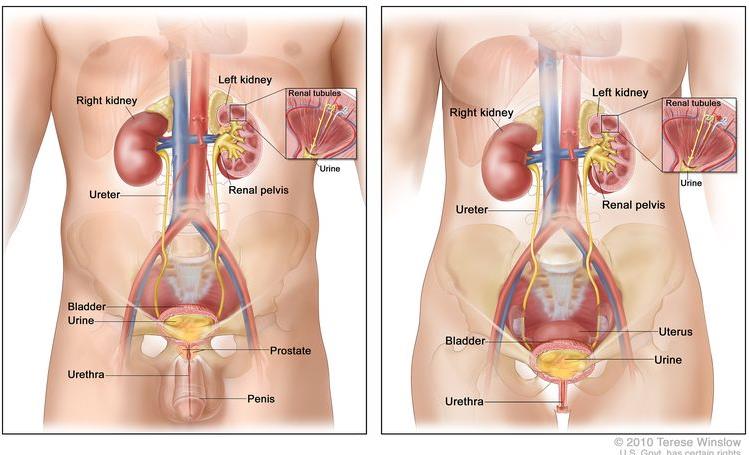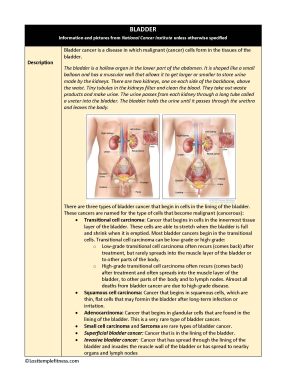Bladder Cancer
Your Body is Your Temple
Research, Resources & Education
Table of Contents
Bladder cancer, a type of cancer in which abnormal cells grow uncontrollably within the bladder, is a serious health concern that can impact both men and women. While the journey to recovery can be challenging, there are certain lifestyle habits that can positively impact your health and wellbeing. Engaging in regular physical activity is one such habit that may promote recovery and enhance overall health. However, it is important to exercise caution after bladder cancer surgery, as overexertion or strenuous activities may cause discomfort or injury. Always consult with your doctor or healthcare professional before embarking on an exercise routine while recovering from bladder cancer.
Information and pictures from National Cancer Institute unless otherwise specified
|
Bladder Description

- The bladder is a hollow organ in the lower part of the abdomen.
- It is shaped like a small balloon and has a muscular wall that allows it to get larger or smaller to store urine made by the kidneys.
- There are two kidneys, one on each side of the backbone, above the waist.
- Tiny tubules in the kidneys filter and clean the blood.
- They take out waste products and make urine.
- The urine passes from each kidney through a long tube called a ureter into the bladder.
- The bladder holds the urine until it passes through the urethra and leaves the body.
Bladder Cancer Videos
YouTube Videos that help explain types of Bladder Cancer.
Disclaimer:
This is for research only and Lost Temple Fitness & Cancer does not endorse any video presented on this website.
It is advised that you ALWAYS CHECK WITH YOUR PHYSICIAN for a proper diagnosis and treatment plan.
Bladder Cancer
Types of Bladder Cancer
There are three types of bladder cancer that begin in cells in the lining of the bladder.
These cancers are named for the type of cells that become malignant (cancerous):
Cancer that begins in cells in the innermost tissue layer of the bladder. These cells are able to stretch when the bladder is full and shrink when it is emptied.
- Most bladder cancers begin in the transitional cells.
- Transitional cell carcinoma can be low- grade or high-grade:
- Low-grade transitional cell carcinoma often recurs (comes back) after treatment, but rarely spreads into the muscle layer of the bladder or to other parts of the body.
- High-grade transitional cell carcinoma often recurs (comes back) after treatment and often spreads into the muscle layer of the bladder, to other parts of the body and to lymph nodes. Almost all deaths from bladder cancer are due to high-grade disease.
Cancer that begins in squamous cells, which are thin, flat cells that may form in the bladder after long-term infection or irritation.
Cancer that begins in glandular cells that are found in the lining of the bladder. This is a very rare type of bladder cancer.
Small cell carcinoma and Sarcoma are rare types of bladder cancer.
- Superficial bladder cancer: Cancer that is in the lining of the bladder.
- Invasive bladder cancer: Cancer that has spread through the lining of the bladder and invades the muscle wall of the bladder or has spread to nearby organs and lymph nodes
Treatments for Bladder Cancer
Information from Cancer Support Community
Also see Treatments
The chemotherapy comes in pills, capsules, or liquids that you swallow mattis, pulvinar dapibus leo.
Surgery in which a cystoscope (a thin lighted tube) is inserted into the bladder through the urethra.
- A tool with a small wire loop on the end is then used to remove the cancer or to burn the tumor away with high- energy electricity.
- This is known as fulguration.
Surgery to remove the bladder and any lymph nodes and nearby organs that contain cancer.
- This surgery may be done when the bladder cancer invades the muscle wall, or when superficial cancer involves a large part of the bladder.
- In men, the nearby organs that are removed are the prostate and the seminal vesicles.
- In women, the uterus, the ovaries, and part of the vagina are removed.
- Sometimes, when the cancer has spread outside the bladder and cannot be completely removed, surgery to remove only the bladder may be done to reduce urinary symptoms caused by the cancer.
- When the bladder must be removed, the surgeon creates another way for urine to leave the body.
Surgery to remove part of the bladder.
- This surgery may be done for patients who have a low-grade tumor that has invaded the wall of the bladder but is limited to one area of the bladder.
- Because only a part of the bladder is removed, patients are able to urinate normally after recovering from this surgery.
- This is also called segmental cystectomy.
Surgery to make a new way for the body to store and pass urine.
- Radiation therapy
- Chemotherapy
- Immunotherapy
Possible Side Effects
TUR:
- Possible bleeding and pain when you urinate after surgery.
Radical cystectomy:
- Women unable to get pregnant and may have early menopause
- Men may be impotent
Segmental cystectomy:
- Increased urination or unable to hold urine.
Radiation therapy:
- Can cause nausea, vomiting, diarrhea, or urinary discomfort.
- Can affect sexuality in both men and women.
- Women may experience vaginal dryness.
- Men may have difficulty with erections.
Chemotherapy:
- Certain drugs used in the treatment of bladder cancer may cause kidney damage.
Recovery from Bladder Surgery
Information from CETI
Please follow MD/surgeon protocol, as every situation is unique.
Transurethral Resection of the Bladder Tumor (TURBT)
Hospital Stay
Full Recovery
Restrictions
Exercise
Partial Cystectomy
Hospital Stay
Full Recovery
Restrictions
Exercise
Radical Cystectomy
Hospital Stay
Full Recovery
Restrictions
Exercise
Disclaimer: The information in this book/website is for educational purposes only and has been obtained through research, publications and personal experience, and shall not be liable for incorrect information. Any mentioned publications or websites does not imply endorsement. As this industry is ever changing, I urge readers to confirm the information contained in this book/website. The author will not be liable for any injuries sustained from practicing techniques taught or for any typographical errors or omissions.
It is advised that you always check with your medical doctor or physical therapist before starting an exercise program or change in diet.
|
Information and pictures from National Cancer Institute unless otherwise specified |




